Key Takeaways
- Agile portfolio management helps organizations align strategy with execution, prioritize high-value work, and respond faster to changing priorities.
- Modern Agile portfolio platforms provide real-time visibility, flow analytics, OKR alignment, and dependency management across multiple portfolios and teams.
- The best Agile portfolio management tools include Businessmap, Jira Align, Planview Portfolios, OnePlan, and Smartsheet, each serving different levels of complexity and methodologies.
- Businessmap stands out for offering end-to-end strategy mapping, Lean-Agile portfolio Kanban, AI insights, proven results, and cost-efficient, transparent pricing.
What Is Agile Portfolio Management?
Agile portfolio management is guidance that applies agile principles to managing multiple projects within an organization. Agile portfolio management emphasizes adaptability, evidence-based decision-making, and connecting strategy with execution.
Agile portfolio management helps organizations:
- Align execution with strategic OKRs
- Improve visibility across teams and value streams
- Reduce overload and chaotic prioritization
- Shorten decision cycles
- Improve predictability using flow metrics and forecasting
- Optimize resource allocation in real time
What Are the 3 Pillars of Agile Portfolio Management?
1. Maintaining Transparency Across the Organization
Agile portfolios require visibility into ongoing projects, risks, and dependencies. As Gartner research reveals, organizations increasingly prioritize portfolio transparency to enable data-driven decisions across strategic initiatives.
Traditional reporting often masks problem areas due to outdated estimates or siloed tools. Agile eliminates this by using connected boards and shared portfolio views to improve situational awareness.
 Visualizing connected strategic and team boards
Visualizing connected strategic and team boards
2. Continuous Improvement through Experimentation
Agile portfolio management encourages rapid experimentation and iterative validation of ideas, using practices such as Cost of Delay (CoD) to determine sequencing. Prioritization becomes data-driven instead of based on assumptions or politics.
3. Aligning Strategy and Execution
True agility demands frequent review cadences, feedback loops, and open communication across teams. Agile portfolio practices help organizations adjust their strategy as markets shift and ensure execution aligns with what matters most.
 Connecting strategic portfolio management with operations using the Portfolio Kanban concept
Connecting strategic portfolio management with operations using the Portfolio Kanban concept
Traditional vs. Agile Portfolio Management
Agile portfolio management removes the overhead of rigid planning cycles and replaces them with flexible, feedback-driven prioritization. It shifts from:
| Traditional PPM |
Agile Portfolio Management |
| Annual budgets |
Continuous, adaptive funding |
| Project-based planning |
Value stream–based portfolio prioritization |
| Centralized control |
Decentralized decision-making |
| Manual reporting |
Real-time operational intelligence |
| Heavy upfront planning |
Iterative validation & continuous improvement |
How to Manage an Agile Portfolio (Step-by-Step)
1. Connect Strategy, Portfolio, and Execution
Use multi-level structures linking strategic OKRs to initiatives, epics, projects, and work items. This ensures decisions reflect organizational goals, not local urgency.
Using tools like Businessmap enables organizations to visualize relationships across multiple workflow layers, from high-level objectives to daily tasks.
Agile portfolio management emphasizes visibility within the portfolio to maintain a shared understanding of project status and progress, bridging the gap between high-level planning and operations.
 Visualizing initiatives and their breakdown into sub-projects and teams in Businessmap
Visualizing initiatives and their breakdown into sub-projects and teams in Businessmap
2. Manage Portfolio Flow
Adopt portfolio Kanban, commitment points, and prioritization models to limit overload and improve delivery speed.
Implementing commitment points helps you indicate when a project is ready for refinement, execution, or delivery. For instance, using the upstream Kanban process before the "Ready to Start" column on your board can help you validate project requests, allowing time to gather details and decide on engagement.
 Visualizing commitment points on a portfolio board
Visualizing commitment points on a portfolio board
3. Review the Portfolio Regularly
Portfolio reviews allow leaders to evaluate risks, dependencies, capacity, and progress holistically. They shift the narrative from individual project updates to system-level flow and outcomes.
Replace annual planning with quarterly, monthly, or continuous reviews to reassess investments, risks, and performance holistically.
4. Analyze Lean-Agile Metrics for Continuous Improvement
Cycle time, throughput, WIP, and probabilistic forecasting (Monte Carlo) provide evidence-based insights to support more accurate decision-making.
Charts like cycle time scatter plots, for instance, can help you monitor project completion times and identify trends or outliers, enabling necessary adjustments.
 Visualizing the average cycle time trend of work items using the Cycle Time Scatter Plot
Visualizing the average cycle time trend of work items using the Cycle Time Scatter Plot
Combine this data with Monte Carlo Simulations for probabilistic forecasting based on historical data, not gut feeling. This approach helps predict outcomes for multiple projects, aligning with your team's actual capabilities.
 Example of work forecasting using Monte Carlo: How Many simulation
Example of work forecasting using Monte Carlo: How Many simulation
What Are the Best Agile Portfolio Management Tools?
The best Agile portfolio management software should support:
1. Businessmap
Businessmap is an enterprise-ready Lean/Agile portfolio management platform built for end-to-end visibility, strategic alignment, and faster delivery. Designed for organizations managing multiple teams and complex initiatives, it provides a connected structure between strategy, portfolios, and execution, enabling leaders to make decisions based on real data, not guesswork.
→ Gartner recognizes Businessmap in the Enterprise Agile Planning (EAP) Tools and Project Portfolio Management categories.
Key Features
- Portfolio & coordination boards connecting strategy to execution
- AI-powered planning canvases and insights
- Multi-level OKR management integrated with execution boards
- Lean analytics: cycle time, flow efficiency, throughput, Monte Carlo forecasts
- Dependency mapping, blockers analytics, and work hierarchies
- Timeline/Gantt for portfolio planning
- Real-time dashboards & heatmaps
- Cross-system integrations (Jira, Azure DevOps, GitHub, Power BI, Tableau, ERP tools)
Pros & Cons & Cons
✓ True strategy-to-execution alignment
✓ Flexible workflows for Agile, hybrid, or traditional teams
✓ Powerful analytics for forecasting, risk visibility, and continuous improvement
✓ Highly customizable with no feature gating
– Requires initial enablement for complex enterprise setups
– On-premise hosting not available
Additional Details
-
Free Trial: 14 days
-
Demo: Guided demos + pre-recorded tours
-
Support: Enterprise onboarding, consulting, training, migration support
-
Pricing: From $8/user/month for 100 users (annual billing), no feature limitations
Proven Outcomes
-
Finance: Cut delivery times by 60%, and boosted productivity by 36% within two months.
-
Energy: 80% visibility increase, 100+ hours saved.
-
Manufacturing: 54% cycle-time improvement.
-
Logistics: 30% productivity lift + lead time reduced from 120 → 63 days.
→ Read Businessmap case studies
Ready to see Businessmap in action?
2. Jira Align
Jira Align is Atlassian’s platform for scaling Agile across portfolios, programs, and teams. It provides deep integration with Jira Software, making it a strong fit for organizations committed to SAFe or large-scale Agile transformations.
Key Features
- Strategic roadmapping and goals management
- Program boards for dependencies and risks
- AI-powered insights on goals and work progress
- Native Jira sync from story to Epic to Portfolio level
- Supports SAFe, LeSS, and enterprise Agile frameworks
Pros & Cons & Cons
✓ Strongest integration with Jira
✓ Excellent for SAFe and large Agile rollouts
– Heavy configuration
– No free trial
– At least one year commitment
– Jira Cloud Premium is a minimum requirement
– Analytics only available with minimum Cloud Enterprise Edition
Additional Details
-
Demo: Personalized demos only
-
Pricing: Part of the Strategy Collection suite at $77,400/year for 1-50 users
-
Support: Atlassian University, enterprise onboarding
3. Planview Portfolios
Planview Portfolios is a mature enterprise portfolio platform ideal for organizations that require deep resource planning, complex strategic prioritization, and financial governance. It supports Agile, hybrid, and traditional planning models.
Key Features
- OKRs and strategic planning
- Demand & capacity management
- Scenario modeling and investment prioritization
- Lean Portfolio Kanban
- Financial management and risk heatmaps
Pros & Cons
✓ Excellent resource governance
✓ Strong analytics and scenario planning
– Complex to implement
– Heavy learning curve
– Custom pricing only
Additional Details
- Demo: Request-only
- Pricing: Custom enterprise pricing
- Support: Tiered support, training, certifications
4. Targetprocess
Targetprocess is a platform supporting Lean portfolio management, OKRs, and hybrid workflows. It’s designed for enterprises scaling Agile across programs and value streams.
Key Features
- Multi-level portfolio and value stream hierarchy
- Dependency and risk visualization
- OKR mapping
- SAFe/LeSS/hybrid workflow support
- Resource and budget management
- Integrations across planning and DevOps ecosystems
Pros & Cons
✓ Excellent visualization
✓ Strong for scaled Agile
✓ Deep strategy-to-execution mapping
– Requires configuration for large-scale setups
Additional Details
-
Trial: Free trial available
-
Demo: Personalized demo
-
Pricing: Custom
-
Support: Tutorials, guided onboarding, learning programs
5. OnePlan
OnePlan is an AI-enabled portfolio and work management platform built for enterprises aligning strategy, financials, and Agile/Waterfall execution. It is especially powerful for organizations relying on Microsoft 365, Azure DevOps, and Planner.
Key Features
- Strategic roadmaps & OKR alignment
- What-If scenarios modelling
- Financial and resource management
- Views: Tree, Gantt, Kanban, Roadmap
- AI assistant (Sofia GPT)
- Deep integrations with Microsoft and Jira
Pros & Cons
✓ Strong Microsoft integration
✓ Robust modeling
✓ AI-powered insights
– Configuration required for advanced setups
– Power BI reports, audit logs and customizable permissions only available with the Enterprise offering
Additional Details
-
Trial: Free trial
-
Demo: Pre-recorded & scenario-based demos
-
Pricing: Free plan + paid plans starting ~$30/user/month
-
Support: Implementation packages, video library, knowledge base
6. Visor
Visor is a lightweight Agile portfolio visualization tool known for its clean interface and powerful two-way integrations with Jira, Asana, and Salesforce. It’s designed as a “connected spreadsheet” that makes portfolio roadmaps and Gantt charts easy to build, customize, and share in real time.
Key Features
- Two-way sync with Jira, Asana, Salesforce
- Gantt charts, roadmaps, Kanban boards, dashboards
- AI-assisted templates for fast setup
- Real-time collaboration and unlimited free viewers
- Easy portfolio sharing without requiring tool licenses
Pros & Cons
✓ Very easy to adopt
✓ Excellent for visualizing Jira/Asana data
– Limited advanced modeling
– Lacks deeper financial governance features
Additional Details
-
Trial: 14-day free trial of the Team plan (three or more licenses)
-
Pricing: Free plan; Business plan from ~$750/month (annual billing)
-
Support: Email/chat support; white-glove onboarding for Business plan
7. Smartsheet
Smartsheet blends collaborative project management with spreadsheet-style usability. It is widely used for lightweight portfolio coordination and cross-team reporting.
Key Features
- Grid, Gantt, calendar, and card views
- Portfolio dashboards
- Automated workflows
- Resource management add-ons
- Easy integrations with tools like Jira, Slack, and Power BI
Pros & Cons
✓ Easy to adopt
✓ Good for reporting and cross-functional collaboration
– Limited Agile portfolio capabilities
– Complex portfolios become hard to maintain
Additional Details
-
Trial: 30 days
-
Pricing: From $9/user/month
-
Support: Onboarding, templates, training resources
FAQs
Which agile portfolio management tools best support epic prioritization, value stream funding, and OKR alignment?
Businessmap, Jira Align, and Planview provide the strongest capabilities for epic prioritization and value stream funding. Businessmap stands out with its integrated OKR-to-execution links and value-based prioritization.
What features do agile PM tools offer for backlog management, continuous delivery, and portfolio Kanban?
Top tools like Businessmap, Jira Align, Targetprocess, and Planview provide backlog scoring, WIP limits, portfolio Kanban, and cross-team dependency mapping. Smartsheet and Visor offer lighter backlog and Kanban features for smaller portfolios.
How do agile portfolio software platforms enable strategy-to-execution alignment and faster time-to-market?
Businessmap, OnePlan, and Targetprocess connect strategy objectives directly to initiatives and team execution, giving leaders real-time visibility into progress, risks, and capacity.
Which agile PM software provides AI-driven insights, risk prediction, and resource optimization for scaled agile?
Businessmap, Planview, and OnePlan offer AI-driven analytics, risk prediction, and forecasting. Businessmap leads with AI-assisted analysis that explains trends and highlights bottlenecks instantly.
Ready to see Businessmap in action?





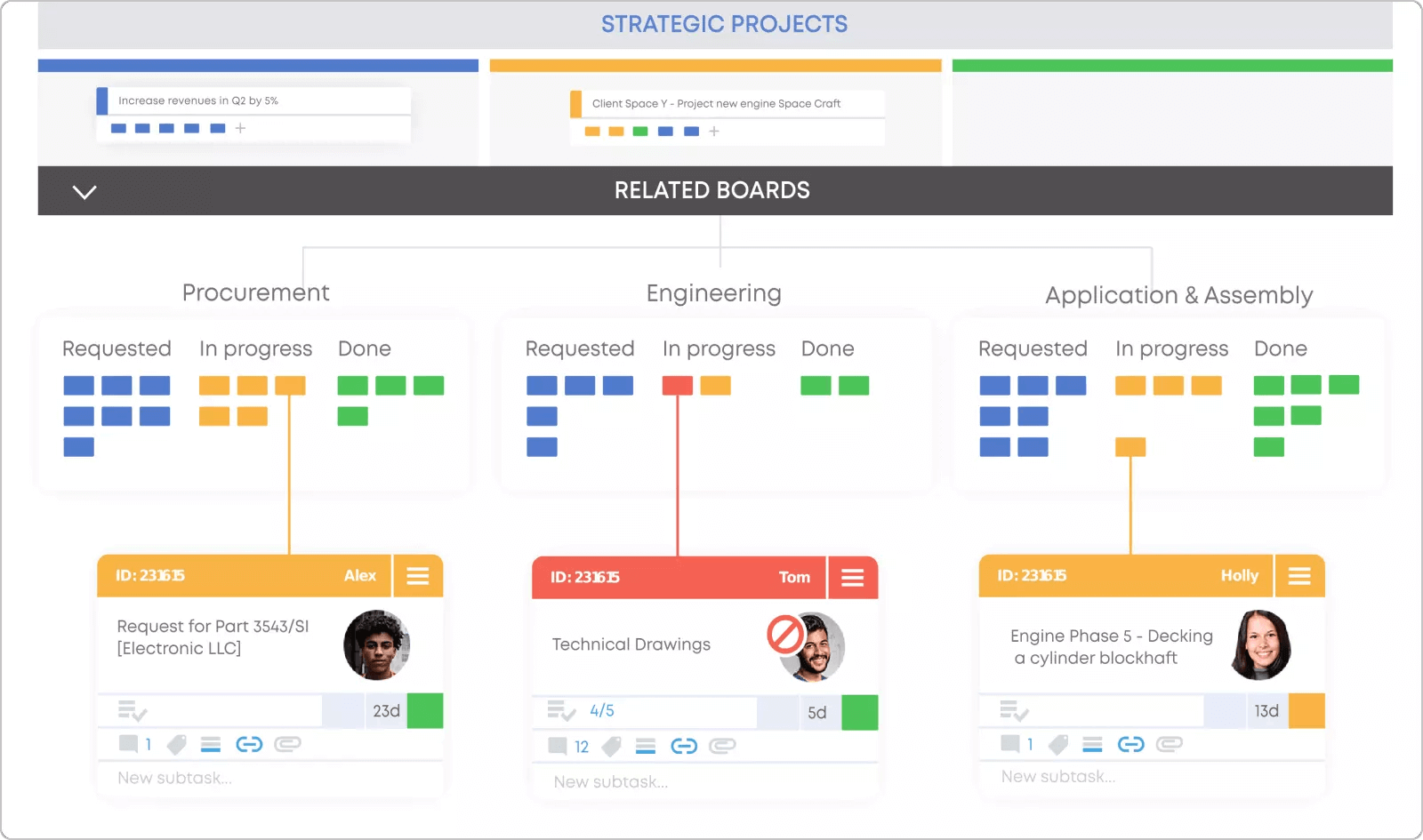 Visualizing connected strategic and team boards
Visualizing connected strategic and team boards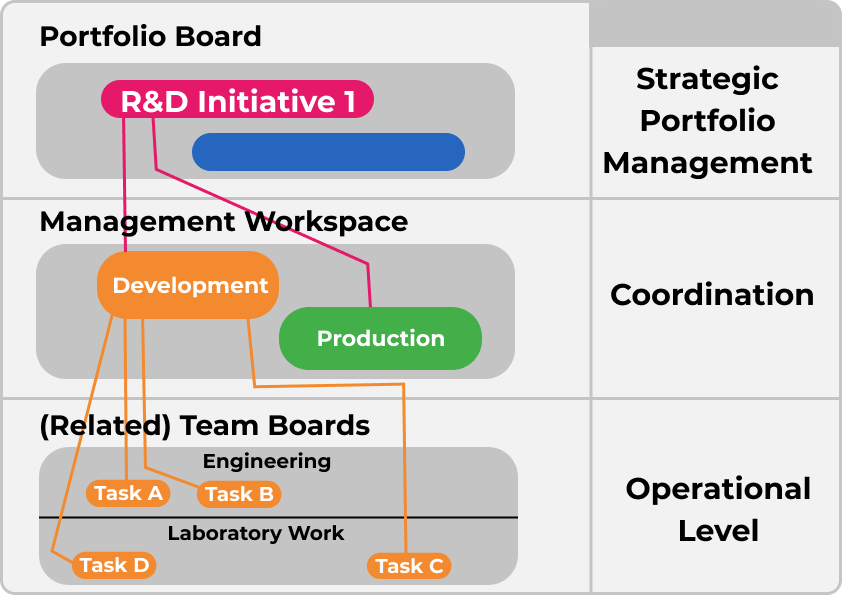 Connecting strategic portfolio management with operations using the Portfolio Kanban concept
Connecting strategic portfolio management with operations using the Portfolio Kanban concept 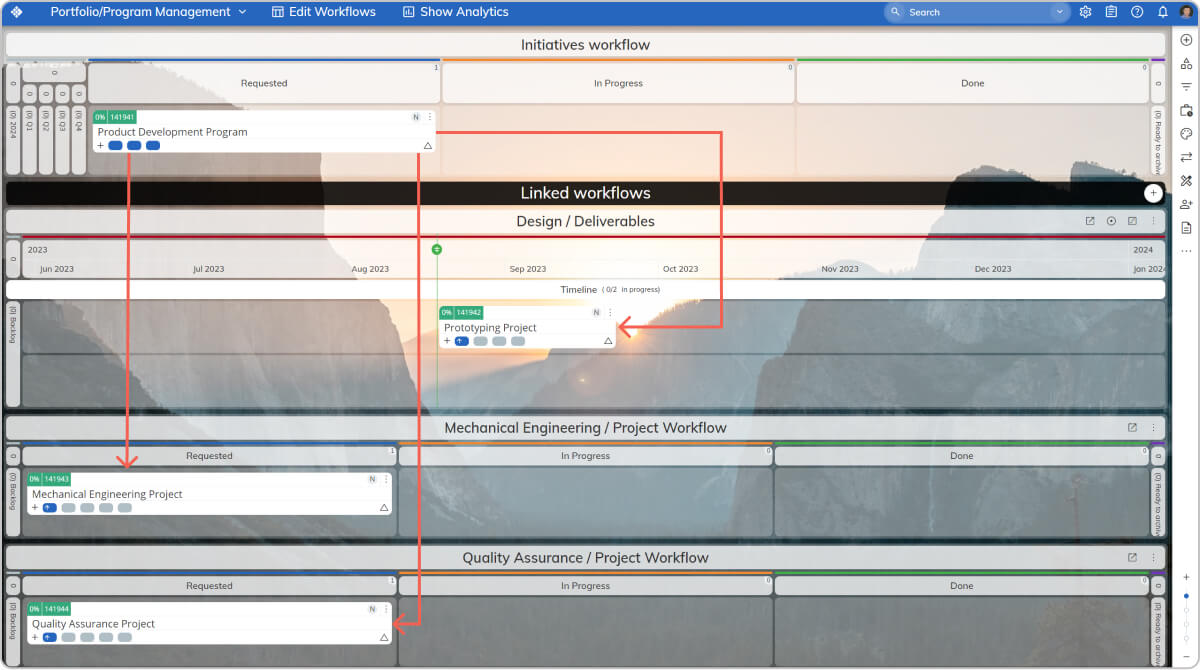 Visualizing initiatives and their breakdown into sub-projects and teams in Businessmap
Visualizing initiatives and their breakdown into sub-projects and teams in Businessmap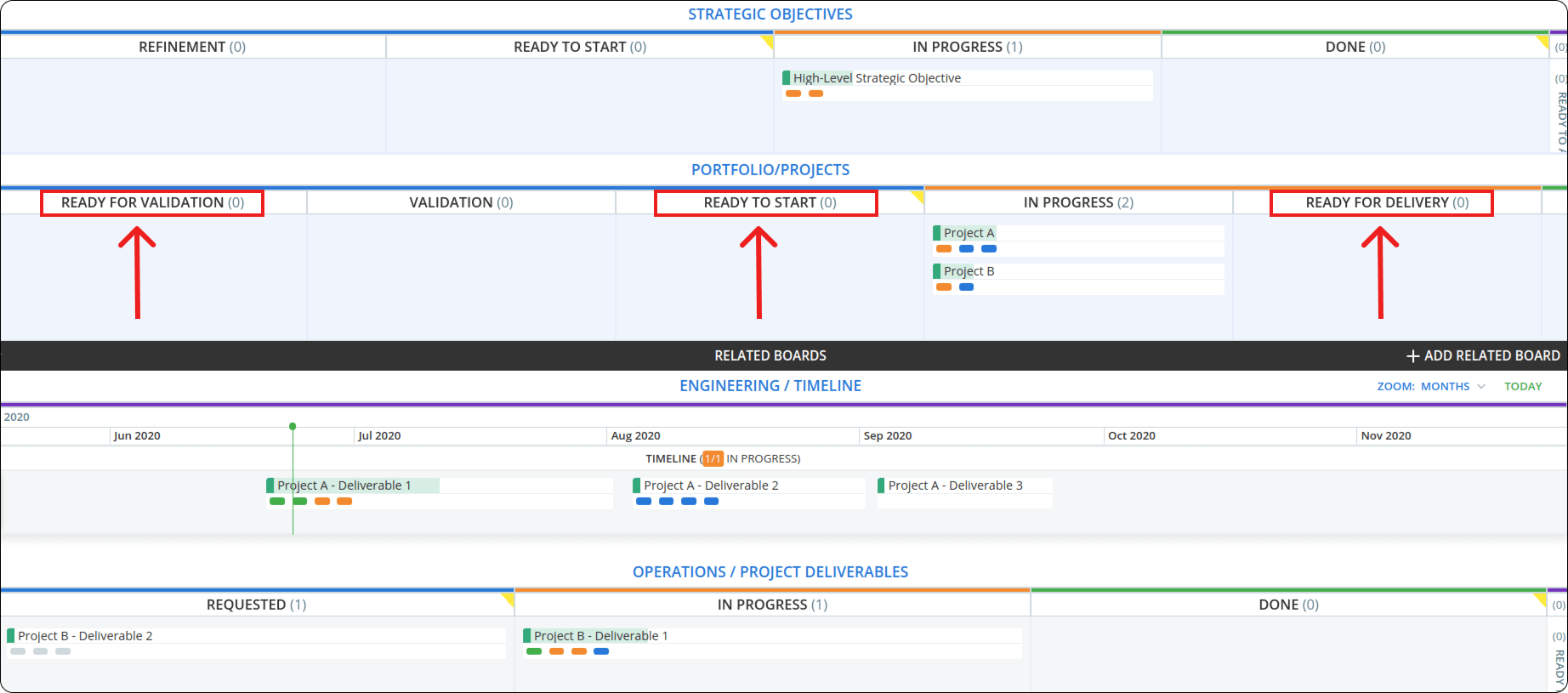 Visualizing commitment points on a portfolio board
Visualizing commitment points on a portfolio board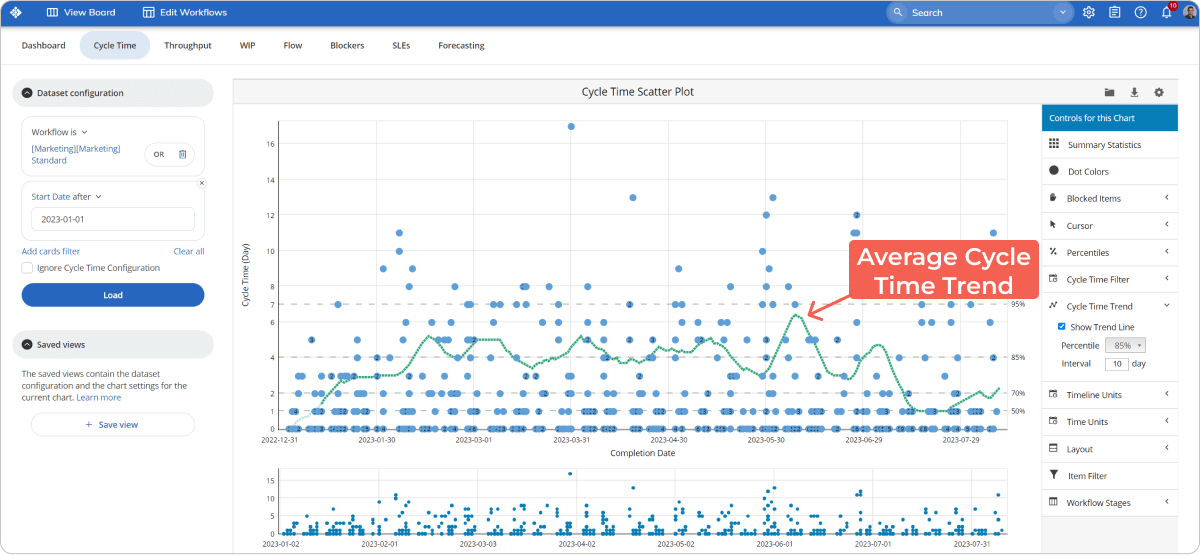 Visualizing the average cycle time trend of work items using the Cycle Time Scatter Plot
Visualizing the average cycle time trend of work items using the Cycle Time Scatter Plot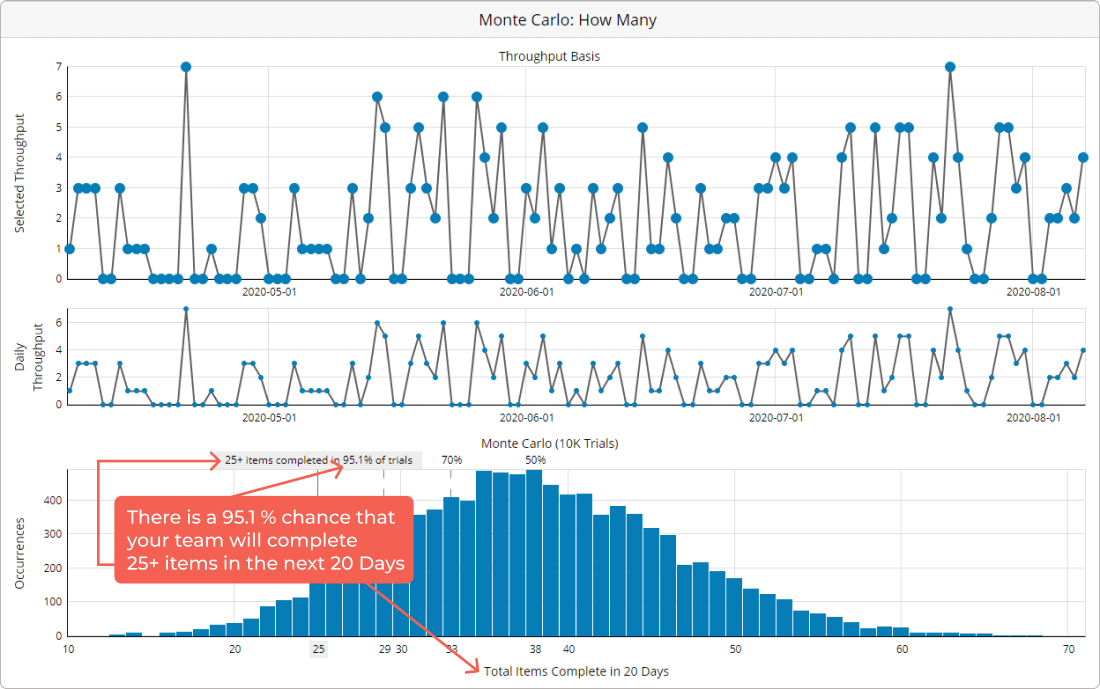 Example of work forecasting using Monte Carlo: How Many simulation
Example of work forecasting using Monte Carlo: How Many simulation

